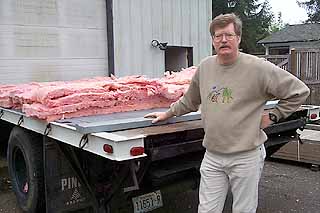|
Subscribe / Renew |
|
|
Contact Us |
|
| ► Subscribe to our Free Weekly Newsletter | |
| home | Welcome, sign in or click here to subscribe. | login |
Construction
| |

December 23, 1999
Life on the leading edge of sustainability
By JON SAVELLE
Journal Environmental editor
Tom St. Louis is betting his future that the construction industry will embrace sustainable building in a big way. And he's doing everything he can to make it happen.
As the sole operator of the T.R. Strong Building Systems Co. in Olympia, St. Louis has carved a niche for himself as a source of information and materials for ecologically-friendly building. He's a dealer and distributor for a range of products, including Rastra building blocks, structural insulating panels, wastewater heat exchangers, energy-recovery ventilators, recycled plastic lumber, plastic sheeting and engineered steel buildings.

Photo by Jon Savelle |
It has been a challenge to gain acceptance for new approaches, St. Louis said. The construction industry is famously averse to experimentation, largely because costs and profits are calculated on the basis of traditional materials and techniques.
But that is changing.
"I'm seeing the whole sustainable movement growing," St. Louis said. "In the last couple of years, I've seen a lot more awareness."
Among the organizations involved are the National Association of Homebuilders, the Ecobuilding Guild, the U.S. Green Building Council and the Washington State Construction Demolition and Landclearing Council. And a host of local businesses, groups and individuals are working to "mainstream" sustainable design and construction practices through the Northwest Regional Sustainable Building Action Plan.
St. Louis himself, ever the educator, is part of a CDL Council effort to create a "toolbox" for the industry to use. To be arranged in sections, by sub-industry, the toolbox will be a comprehensive source of information on materials and techniques for green building.
But hurdles remain. Even though more and more builders and designers -- and their clients -- are demanding green projects, St. Louis said the low-bid method of awarding contracts works against them. Low bids often result in cheap, flimsy buildings, he said, which end up being demolished and sent to a landfill much sooner than a well-built structure would.
This represents a cost that is more than just environmental. Demolition, hauling and landfilling charges all add up. And it is a waste of money to buy an inferior product to begin with.
St. Louis believes that awareness of these costs is what will pull the industry toward sustainable practices. He's sure that the heavy hand of regulation is not the answer.
"That gets everybody's hackles up," he said.
As the industry gradually shifts toward sustainability, St. Louis says it will create a demand for people with knowledge and skills in that area. He himself expects to hire some help this spring, and he predicts that training programs will see increasing interest in their graduates.
Those programs are gearing up. Peter Hurley, of Seattle City Light, helped develop curriculum for a new, six-month "Sustainable Building Advisor" program at Seattle Central Community College. Other programs are offered by The Evergreen State College and the University of Washington.
Beyond those, the industry already has some leaders of its own. St. Louis named the Sellen, Baugh and Turner construction companies as good examples of how to integrate sustainability into day-to-day operations. Other examples are Olympia contractor Jones & Jones, The Boeing Co. and Mayer Built Homes.
As others join their ranks, St. Louis said, sustainable building and design at some point will surge into the mainstream. Then it will be time to look at the next step.
And what might that be?
St. Louis believes it will be the mining old landfills for useful materials.
Previous columns:
- Commuter Building now a traffic-stopper, 11-18-1999
- Permeable pavement can reduce storm runoff, 11-04-1999
- Job order contracting may come to local agencies, 10-28-1999
- Industry out to rebuild reputation of EIFS, 10-21-1999
- Sparking change in Columbia City Rectifier building, 10-14-1999


